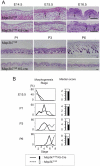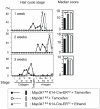Inflammatory mediator TAK1 regulates hair follicle morphogenesis and anagen induction shown by using keratinocyte-specific TAK1-deficient mice
- PMID: 20585657
- PMCID: PMC2890581
- DOI: 10.1371/journal.pone.0011275
Inflammatory mediator TAK1 regulates hair follicle morphogenesis and anagen induction shown by using keratinocyte-specific TAK1-deficient mice
Abstract
Transforming growth factor-beta-activated kinase 1 (TAK1) is a member of the NF-kappaB pathway and regulates inflammatory responses. We previously showed that TAK1 also regulates keratinocyte growth, differentiation, and apoptosis. However, it is unknown whether TAK1 has any role in epithelial-mesenchymal interactions. To examine this possibility, we studied the role of TAK1 in mouse hair follicle development and cycling as an instructive model system. By comparing keratinocyte-specific TAK1-deficient mice (Map3k7(fl/fl)K5-Cre) with control mice, we found that the number of hair germs (hair follicles precursors) in Map3k7(fl/fl)K5-Cre mice was significantly reduced at E15.5, and that subsequent hair follicle morphogenesis was retarded. Next, we analyzed the role of TAK1 in the cyclic remodeling in follicles by analyzing hair cycle progression in mice with a tamoxifen-inducible keratinocyte-specific TAK1 deficiency (Map3k7(fl/fl)K14-Cre-ER(T2)). After active hair growth (anagen) was induced by depilation, TAK1 was deleted by topical tamoxifen application. This resulted in significantly retarded anagen development in TAK1-deficient mice. Deletion of TAK1 in hair follicles that were already in anagen induced premature, apoptosis-driven hair follicle regression, along with hair follicle damage. These studies provide the first evidence that the inflammatory mediator TAK1 regulates hair follicle induction and morphogenesis, and is required for anagen induction and anagen maintenance.
Conflict of interest statement
Figures







Similar articles
-
Transforming growth factor-beta-activated kinase 1 is essential for differentiation and the prevention of apoptosis in epidermis.J Biol Chem. 2006 Aug 4;281(31):22013-22020. doi: 10.1074/jbc.M601065200. Epub 2006 Jun 5. J Biol Chem. 2006. PMID: 16754690
-
TGF-β1-activated kinase-1 regulates inflammation and fibrosis in the obstructed kidney.Am J Physiol Renal Physiol. 2011 Jun;300(6):F1410-21. doi: 10.1152/ajprenal.00018.2011. Epub 2011 Mar 2. Am J Physiol Renal Physiol. 2011. PMID: 21367917
-
Integrin β6-deficient mice show enhanced keratinocyte proliferation and retarded hair follicle regression after depilation.J Invest Dermatol. 2012 Mar;132(3 Pt 1):547-55. doi: 10.1038/jid.2011.381. Epub 2011 Nov 24. J Invest Dermatol. 2012. PMID: 22113470
-
Molecular biology of hair morphogenesis: development and cycling.J Exp Zool B Mol Dev Evol. 2003 Aug 15;298(1):164-80. doi: 10.1002/jez.b.33. J Exp Zool B Mol Dev Evol. 2003. PMID: 12949776 Review.
-
Epithelial growth control by neurotrophins: leads and lessons from the hair follicle.Prog Brain Res. 2004;146:493-513. doi: 10.1016/S0079-6123(03)46031-7. Prog Brain Res. 2004. PMID: 14699982 Review.
Cited by
-
Identification of common biological pathways and drug targets across multiple respiratory viruses based on human host gene expression analysis.PLoS One. 2012;7(3):e33174. doi: 10.1371/journal.pone.0033174. Epub 2012 Mar 14. PLoS One. 2012. PMID: 22432004 Free PMC article.
-
Arctiin blocks hydrogen peroxide-induced senescence and cell death though microRNA expression changes in human dermal papilla cells.Biol Res. 2014 Sep 30;47(1):50. doi: 10.1186/0717-6287-47-50. Biol Res. 2014. PMID: 25299961 Free PMC article.
-
Depilatory creams increase the number of hair follicles, and dermal fibroblasts expressing interleukin-6, tumor necrosis factor-α, and tumor necrosis factor-β in mouse skin.Korean J Physiol Pharmacol. 2021 Nov 1;25(6):497-506. doi: 10.4196/kjpp.2021.25.6.497. Korean J Physiol Pharmacol. 2021. PMID: 34697260 Free PMC article.
-
Deconvolving organogenesis in space and time via spatial transcriptomics in thick tissues.bioRxiv [Preprint]. 2024 Sep 24:2024.09.24.614640. doi: 10.1101/2024.09.24.614640. bioRxiv. 2024. PMID: 39386671 Free PMC article. Preprint.
-
Gata6 promotes hair follicle progenitor cell renewal by genome maintenance during proliferation.EMBO J. 2017 Jan 4;36(1):61-78. doi: 10.15252/embj.201694572. Epub 2016 Dec 1. EMBO J. 2017. PMID: 27908934 Free PMC article.
References
-
- Sato S, Sanjo H, Takeda K, Ninomiya-Tsuji J, Yamamoto M, et al. Essential function for the kinase TAK1 in innate and adaptive immune responses. Nat Immunol. 2005;6:1087–1095. - PubMed
-
- Yamaguchi K, Shirakabe K, Shibuya H, Irie K, Oishi I, et al. Identification of a member of the MAPKKK family as a potential mediator of TGF-beta signal transduction. Science. 1995;270:2008–2011. - PubMed
-
- Takaesu G, Kishida S, Hiyama A, Yamaguchi K, Shibuya H, et al. TAB2, a novel adaptor protein, mediates activation of TAK1 MAPKKK by linking TAK1 to TRAF6 in the IL-1 signal transduction pathway. Mol Cell. 2000;5:649–658. - PubMed
-
- Takaesu G, Surabhi RM, Park KJ, Ninomiya-Tsuji J, Matsumoto K, et al. TAK1 is critical for IkappaB kinase-mediated activation of the NF-kappaB pathway. J Mol Biol. 2003;326:105–115. - PubMed
Publication types
MeSH terms
Substances
LinkOut - more resources
Full Text Sources
Molecular Biology Databases
Research Materials
Miscellaneous

